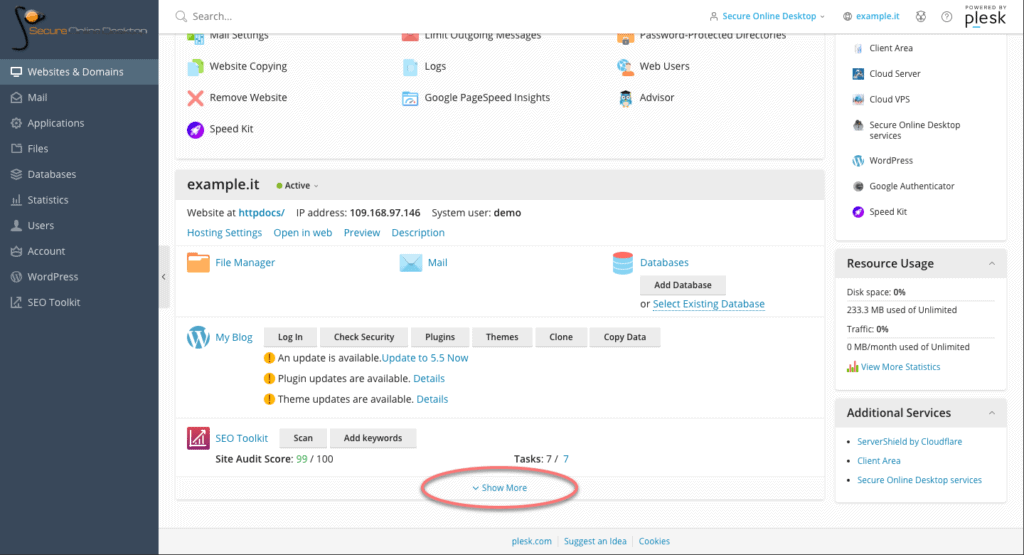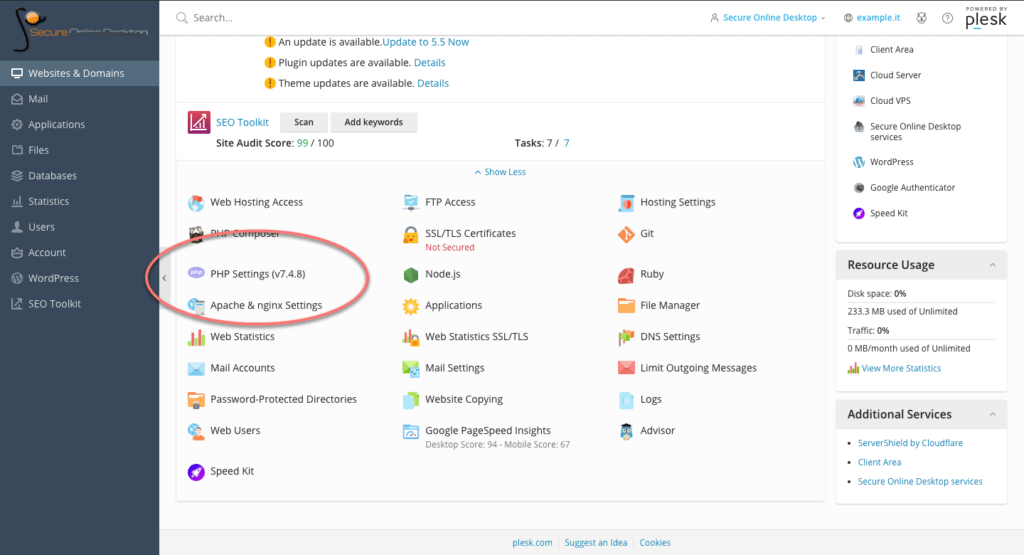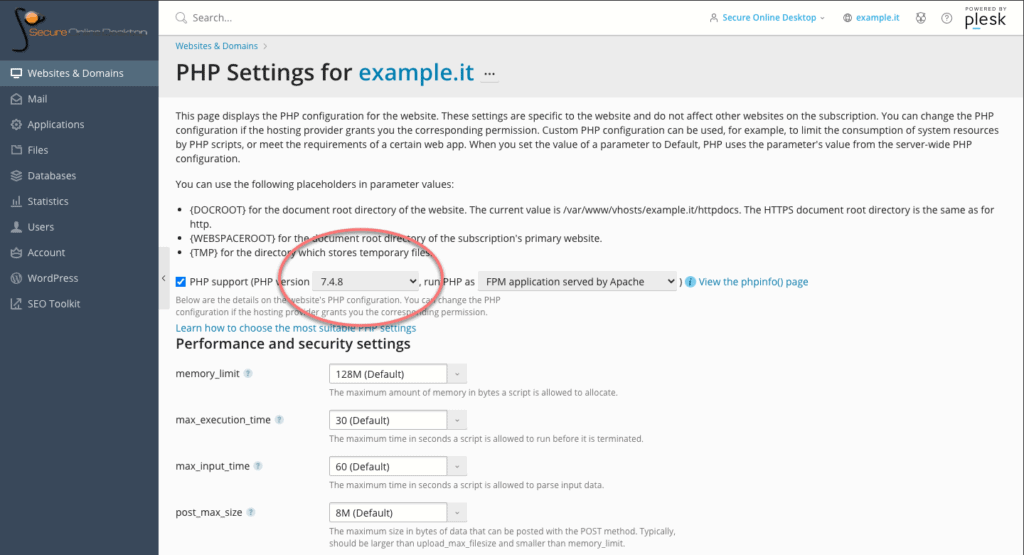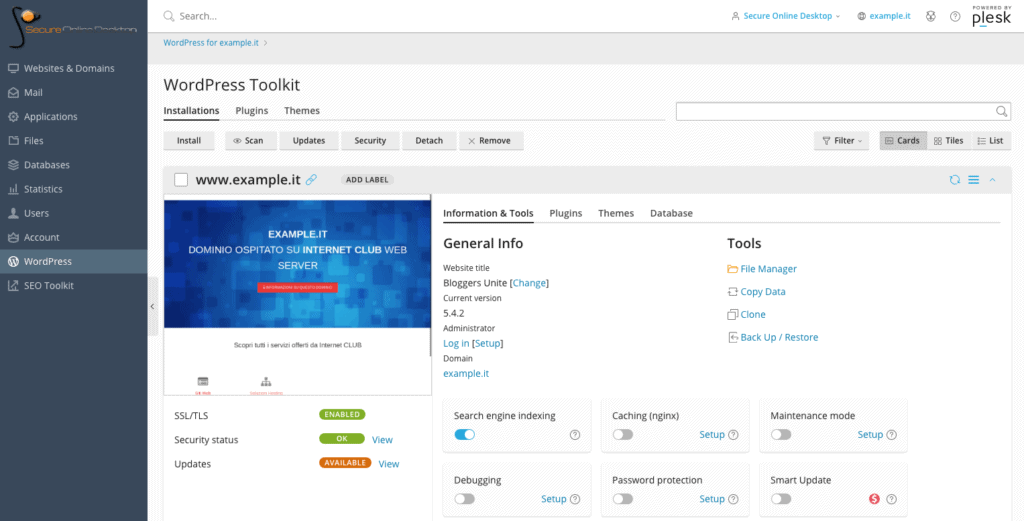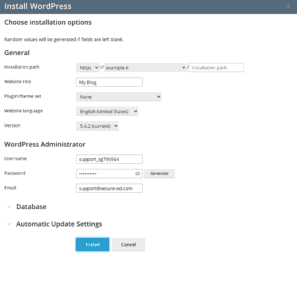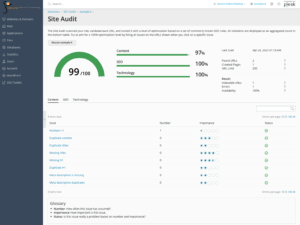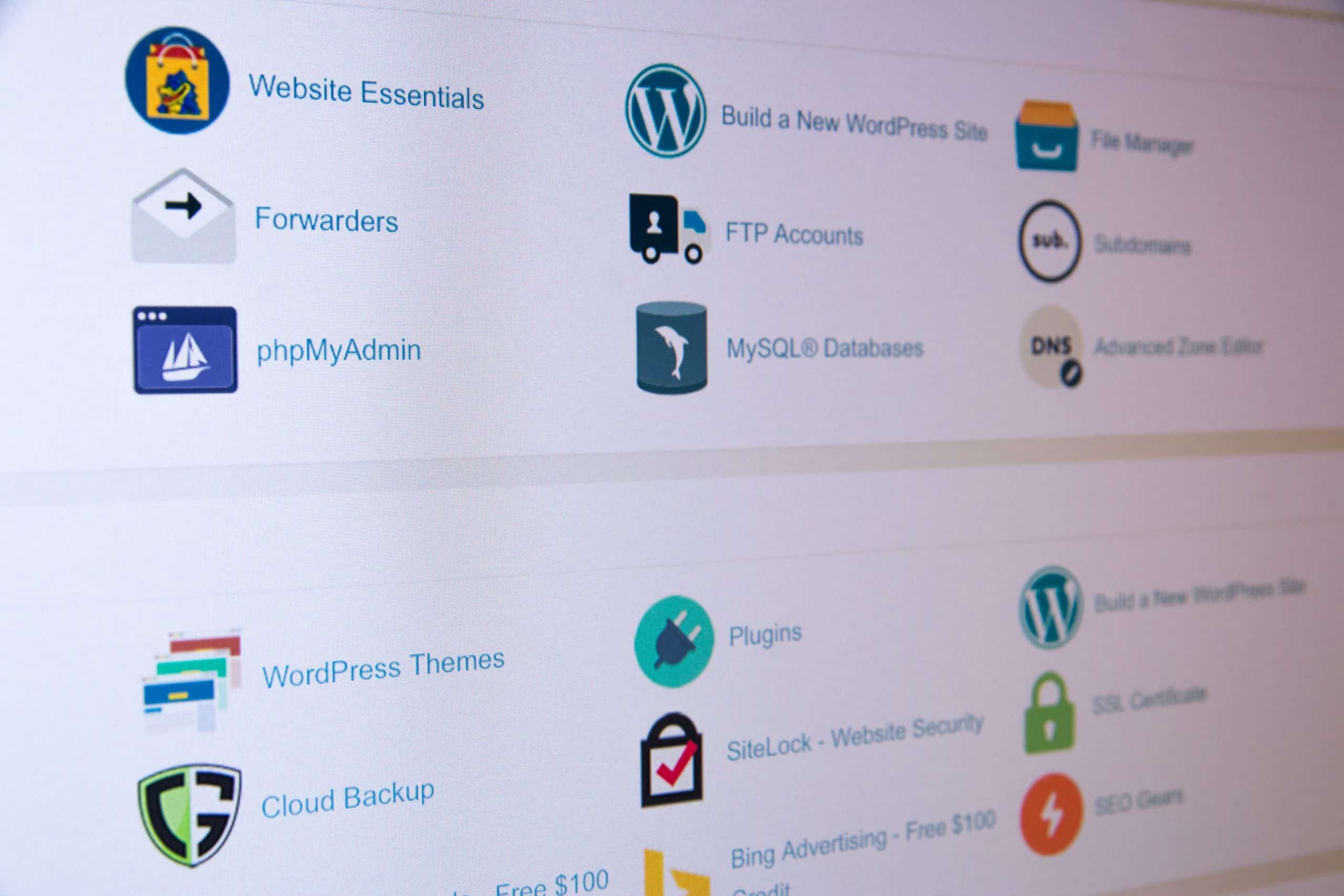
Most hosting environments use an intuitive interface to help users manage their web spaces. Two very famous panels are cPanel and Plesk, widely used and offered in the SaaS formula. Without these graphical interfaces, it would be difficult to manage a hosting space and set up a site. A lot of time is usually spent managing a web space through a control panel, consequently, the choice of a provider should also be made based on the panel it offers, how user friendly it is and what features are immediately available.
Let’s see what are the generic advantages of a web panel and try to understand why the use of a product like Plesk is to be preferred.
Why use a web panel?
A web panel is essentially a hosting management tool. It allows you to do things like organize site files, manage installed applications, email and much more. Providers offer a panel to help their customers effectively manage their sites. Without such a dashboard, managing a web portal and server would be much more complicated and would require a lot of additional skills.
The great advantage of control panels is that they allow users to set up and manage complicated processes with the click of a button.
Some things that can be done simply with a click: install a CMS, generate a subdomain, install software on the server and much more. All this is just the tip of the iceberg of what a panel like cPanel or Plesk can do.
Common features of web panels
Regardless of which web panel you end up using, you will likely have access to a similar set of functions. Below we take a look at what these features are.
DNS management
DNS is the acronym for domain name management system. Most web panels provide the tools you need to manage domains, connect them to an existing site, redirect domains, and much more.
File and database management
These features allow you to manage the files of your web space through the cPanel and Plesk panels. With the management via FTP it will be possible to access the single files of the site, in some cases directly from the panel, and to modify them as desired. The database management offers the same editing function for the tables and the data contained within it. It may not be necessary to use these features often, but they are essential to have full control of your site.
Email management
Having an email address associated with the domain name helps the site look professional. With the e-mail management functions you are able to set a specific e-mail address for the domain, send and receive e-mails and other operations related to messaging.
Backup management
The backup of the web portal is incredibly important for the security of your data. it is a great way to help mitigate risks in case the site is hacked, or if there is a problem blocking the site. With a regular backup system, it is easy to restore a previous version of the site in case of need.
Installation of applications and software
Most control panels have various software and applications that can be installed with just one click. One of the most common uses is to allow you to install popular software like Joomla !, or WordPress, with the click of a button.
Why choose cPanel or Plesk
If it is true that web panels often offer similar functionalities, the solutions to offer a user interface to their customers are different and can be divided into two broad categories: providers who rely on services such as cPanel or Plesk, and those who instead use a customized panel with all the resulting risks.
The choice of a control panel developed by companies specialized in the service is a safety in terms of stability, support and potential. Products like the ones we are about to describe have years of experience behind them, large communities and many users who can guarantee that every problem is identified and solved in the shortest possible time.
These obvious benefits are not available on custom web panels or developed directly by service providers to save money. When it comes to the security and stability of your site, don’t take any chances.
cPanel
it is one of the most popular panels and one of the most used, although only available for Linux servers. Its features include both an interface for the end user and one for managing the server via WHM. It is also possible to expand its functionality with additional packages.
cPanel is one of the most popular web panels available today. With its wide variety of features, intuitive interface and extensive customization options it has been designed to meet a broad spectrum of hosting needs.
Plesk
Plesk is available for both Linux and Windows environments. it is one of the easiest to use control panels available for the Windows hosting environment. It offers a very clean user interface and multiple product options to suit different hosting environments. It also allows the management of access by the end user.
Plesk is also the panel in use in our web hosting service. Try the panel with the free demo!
Its intuitive graphical interface is designed to eliminate the hard work of managing the host. It offers a suite of tools to improve the security of your site and the development environment in general. A variety of different automation tools are also available, so you can focus on your own websites and not on infrastructure maintenance.
[btnsx id=”2931″]
Useful links:
Manage WordPress from the hosting panel
Control Panel(Opens in a new browser tab)

PHP is one of the most popular scripting languages on the web today. According to W3Techs, PHP is used by over 82% of all websites that use a server-side programming language. This means that 8 out of 10 sites use PHP in one form or another. Being a scripting language, it is essential to update PHP to the latest version available, unless you have special needs.
Today we try to understand the importance of updating to the latest PHP versions, not only for security reasons, but also to improve performance and support. The precise procedure will also be shown via a simple how-to.
When to update PHP?
As with any software, PHP has a lifecycle that it must adhere to in order to continue making improvements and moving forward in development. Each major PHP release is generally fully supported for two years. During this time, bugs and security issues are regularly fixed and fixed. a third year of support is guaranteed, only for what concerns language security and not performance.
PHP versions supported
As of today (summer 2020), anyone running a version of PHP 7.1 or lower no longer benefits from security support and is exposed to vulnerabilities that will not be fixed. According to the official WordPress Stats page, at the time of writing this article, over 41% of WordPress users are still using PHP 7.1 or lower. This is not only a security issue, but it is also a hindrance as there are still many sites that do not take advantage of the further performance improvements introduced with PHP 7.2 and later.
Unfortunately, not everyone is aware of the danger and since updating PHP is an operation that must be done on the server and not from the site itself, a good portion of users do not even know how to proceed.
 As can be seen from this image, the currently supported versions of PHP are 3: 7.2, whose security support will end on November 30, 2020; 7.3, supported until December 2021 and 7.4 supported until November 2022. Warning: in the last 12 months of the version’s life, the only guaranteed support is the security one.
As can be seen from this image, the currently supported versions of PHP are 3: 7.2, whose security support will end on November 30, 2020; 7.3, supported until December 2021 and 7.4 supported until November 2022. Warning: in the last 12 months of the version’s life, the only guaranteed support is the security one.
Slow updates
There are many factors that could affect a slow adoption of recent versions of the language, here are some of them:
1. The owners of the sites, not being technicians, do not know the language and do not know they have to update PHP in order to have a safe and up-to-date site.
2. Those who use custom themes or plugins on their site want to be sure that the new PHP versions do not have backwards compatibility problems. These developers are waiting for the new guidelines to be released for the most recent versions, and only after checking their plugins and themes do they fully adopt the new version.
3. Some hosts are afraid to update the language on the server as it could lead to a wave of support tickets. Luckily, providers increasingly make the choice of version available to the end user, as we will see shortly.
Honestly, I don’t understand all this fear of updating PHP and keeping your systems running well and safe. I think the wait is quite useless and risky.
How to update PHP on SOD hosting panel
First, log into your control panel and from the main dashboard, scroll down to the section of the site concerned. At the bottom, click on the “Show More” button to view hosting options.
Among the options, look for the one called “PHP Settings”. Note that the version currently in use by the server is already shown next to the name. Click on the option to land on the PHP settings page.
Within the PHP section, it is possible, through a drop-down menu, to change the version in use. Versions that are no longer updated are marked as “outdated”, but still selectable.
On the page, in addition to the version active on the server, it is possible to modify many other PHP options relating to performance and security. For example the limit of the dedicated memory, the maximum execution time of the scripts, the location of the scripting folders and so on.
These are all features that the average user does not need on a daily basis, but the fact that such in-depth control of PHP options is available is a plus for the flexibility of the control panel and service.
Make sure your host is using the latest versions of PHP
As we have seen, updating PHP to the supported version is a simple operation to be performed through the appropriate panel of the hosting plan.
A few years ago, a great article titled “Whipping Your Host Into Shape” by Joost de Valk went into detail about how the real problem is that providers don’t adopt recent versions faster and, even if they do, they don’t encourage users to update themselves. Years have passed since that article and I hope that the trend will improve, and that more and more people think about the security of their portals also through the updating of the infrastructure that hosts them.
Through the control panel of SOD hosting plans, keeping the service updated and secure is simple, and updating PHP is just an example of the potential of the panel itself. Check for yourself by accessing a demo of the service.
[btnsx id=”2931″]
Useful links:
Manage WordPress from the hosting panel

With Secure Online Desktop hosting plans, you have access to a convenient control panel. In addition to the collection of all information on the status of the server, the management of mailboxes and files, it is also possible to access a dedicated panel to manage WordPress in all its aspects. The section of the panel is called WordPress Toolkit and today we deepen it to understand when it is useful.
Manage WordPress from the hosting panel
WordPress is really widespread, so much so that 37% of all websites use this CMS. If we compare the numbers that concern only its competitors, such as Joomla !, Drupal or Wix (to name a few), then WordPress appears in 62% of web platforms that use a Content Management System. (Data from W3Techs.com)
WordPress is powerful, expandable, modular and flexible. It lends itself perfectly to build blogs, ecommerce, company sites and even forums, with the appropriate plugins. For its wide diffusion, the hosting control panel offers a special section to manage WordPress.
Install and manage a WordPress site
Once you have accessed the control panel, just go to the WordPress toolkit section and click on the install button. A screen will appear asking for more information for the installation.
The installation options include: installation path (different instances of WordPress can be installed on different paths), site name, theme to be installed (or plug-in packages), the language of the site and even the version of WordPress. Other options concern the administrator username and password, the database and automatic updates.
Really interesting is the possibility of installing package sets during WordPress installation. The choice includes three sets of plugins: essential, e-commerce and classic, with and without the addition of the Jetpack plugin.
Updates
Once installed, the management of the WordPress site is facilitated by being able to install, enable and disable plugins and themes on the site. Being able to do this without accessing the site backend helps to manage all the portal functions even more immediately.
It is in fact possible to update everything with a simple click, simply by pressing the updates button and then giving confirmation.
Security management
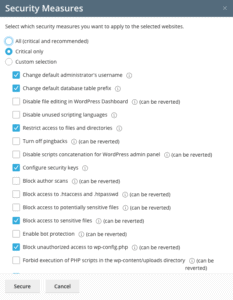 Once the site is installed, by clicking on security, you access a list of site security options. Security measures such as changing the default name of the administrator user and the prefix of the database tables are automatically recommended and enabled, but it is possible to operate options such as protecting files from the WordPress dashboard, excluding pingback and protection from bot.
Once the site is installed, by clicking on security, you access a list of site security options. Security measures such as changing the default name of the administrator user and the prefix of the database tables are automatically recommended and enabled, but it is possible to operate options such as protecting files from the WordPress dashboard, excluding pingback and protection from bot.
Everything is easily selectable from a list of items and then, by clicking on Secure, the measures are put into practice.
SEO WordPress from the hosting panel
Installing, managing and securing our WordPress site are just some of the advantages that the SOD hosting control panel offers. A really interesting feature is that offered by the SEO toolkit panel.
By accessing this section of the hosting service dashboard, you access the valuable SEO information relating to the domain we are managing. It is possible to check which keywords are used on the site and the positioning of the domain in the search results.
By clicking on details, in the site audit section, you can view in detail the various factors that make up the SEO score of the site.
Importance of SEO
Most of the common SEO techniques are geared towards obtaining well-organized web pages full of interesting content for users who visit the pages. Research carried out in April 2020 shows how some of the most popular techniques have an effective impact on positioning.
Positioning in search results depends on many factors. Some depend on the quantity and density of the keywords in a text, the correctness of the content, the number of outgoing and incoming links, how the titles and other factors of this kind are written.
SEO and WordPress from the SOD hosting panel
The SOD hosting control panel provides SEO analysis and tips for the installed site. The SEO techniques to be applied to have a good positioning are deduced by analyzing the search results and checking the Google release notes regarding its indexing algorithm. SEO is therefore very important, but at the same time linked to many factors and details of a certain page or article, as we have seen before.
In the Site Audit section, under SEO toolkit, in the hosting management panel, you can find a list of possible problems and their relevance for the SEO of the domain.
The possible problems are divided into three areas: content, SEO and technology. Each entry provides a number of instances of detecting the problem on the site. By clicking on the item, information is provided on what to do and not to do regarding the topic, as well as the pages on which it was found, to correct it.
Being able to rely on a tool that analyzes and verifies SEO on your site is not at all obvious. Most of the time it would be necessary to rely on special plugins for the analysis of your site, but thanks to the functionality offered by our hosting control panel, the analysis is already available.
Conclusion
To manage a wordpress site you need patience and a good knowledge of the product. Thanks to the functionality of the SOD hosting panel, it is possible to simplify the process by centralizing the management of plugins and themes, as well as the analysis and verification of SEO techniques, in a single and convenient control panel.
You can try these features by accessing a panel demo. You can test firsthand how simple it is to have everything under control and manage your WordPress site more efficiently.
[btnsx id=”2931″]
Useful links:
CloudFlare free Plesk Webhosting users
Let’s Encrypt free certificates for all Webhosting users
Server hosting for SOD web site
VPS host services – Cloud server

Online hosting is the process of using space on a remote server to host a website. The content of the pages (HTML, CSS, images, etc.) must be loaded into the server space to be reached online.
Website hosting service providers have servers, connectivity and associated services for hosting online pages. By offering a variety of plans for online hosting, they cover a wide range of needs: from small blogs to large organizations.
Choosing the online hosting plan means selecting the right resource allocation to keep the portal fast and reliable for visitors. If there is a problem while browsing a site, for example it takes too long to load, potential customers will probably leave.
Online hosting and site domain
The first thing to do to open a web space is to buy a domain. Often providers also offer the sale and management of domains, as well as online hosting. The service provider ensures that when users search for the domain on the network, they are directed to the server hosting the linked site.
Choose hosting for a website
Selecting the appropriate online hosting plan is an important step for online presence, especially if you are launching a corporate website. Providers also offer server management services, but also software, support, bandwidth and speed.
Always keep in mind when choosing an online hosting plan: nothing is free. What seems free often has a non-economic cost.
Website Hosting – The Importance of Bandwidth
Bandwidth (sometimes referred to as “traffic” or “data transfer”) is the number of bytes needed to transfer the site to visitors. A rough example of a site’s typical traffic requirements: most portals that don’t provide video or music use less than 3 gigabytes of bandwidth per month.
If you are expecting a rapid expansion or need to use audio and video on the site, you should consider purchasing a plan that offers extra space. Free hosting for the website is not recommended, because daily or monthly limits are usually imposed on the amount of usable traffic.
Evaluate expansion options
Most new sites start with shared online hosting spaces, which are quite powerful nowadays. However, if the site is expected to grow over the years, it will be necessary to consider the use of greater resources, or even a more powerful server, a VPS (Virtual Private Server) or VDS (Virtual Dedicated Server), for example .
Providing plans that offer more resources from the provider will save time and money by avoiding a migration to other suppliers.
Uptime (reliability)
Reliability is extremely important for this type of service. Real reliability is present only with a paid online hosting plan. A website should work 24/7, and the guarantee that this will only happen with reliable providers and stable network connections.
A site that is difficult to reach or that is often out of order, loses visitors and customers. This negatively affects the authority of the domain. Furthermore, an unavailable site prompts you to visit that of the competition. Bandwidth is also very frustrating and similarly affects users.
Website Hosting – The Control Panel (Plesk)
The purpose of a panel is to allow the management of the various aspects of the account for hosting the website. It is normally offered by each commercial host to carry out normal maintenance operations without having to request technical intervention. A Plesk also provides a simple dashboard to manage email addresses, account passwords and basic server configurations.
If you also want to host e-mail accounts together with the website, you must check that the online hosting plan provides for the setting of e-mail addresses linked to the domain. it is unprofessional to have an unassociated email address. Does an address like [email protected] or [email protected] seem more authoritative?
Concluding
Choosing the right provider and the right online hosting plan for your site is not easy, many factors come into the day. It is certainly important to think about it before starting a project and take the right time to evaluate the options available. This will save time and money in the future.
SOD offers several quality web hosting plans, suitable for various situations and needs. The service is hosted on the Linux platform, which is by far the most adopted and secure server solution in the world. Check the rating on Google for further quality assurance of the service offered!
[btnsx id=”2931″]
Useful links:
Customers
Twitter FEED
Recent activity
-
SecureOnlineDesktop
Estimated reading time: 6 minutes L'impatto crescente delle minacce informatiche, su sistemi operativi privati op… https://t.co/FimxTS4o9G
-
SecureOnlineDesktop
Estimated reading time: 6 minutes The growing impact of cyber threats, on private or corporate operating systems… https://t.co/y6G6RYA9n1
-
SecureOnlineDesktop
Tempo di lettura stimato: 6 minuti Today we are talking about the CTI update of our services. Data security is… https://t.co/YAZkn7iFqa
-
SecureOnlineDesktop
Estimated reading time: 6 minutes Il tema della sicurezza delle informazioni è di grande attualità in questo peri… https://t.co/tfve5Kzr09
-
SecureOnlineDesktop
Estimated reading time: 6 minutes The issue of information security is very topical in this historical period ch… https://t.co/TP8gvdRcrF
Newsletter
{subscription_form_1}© 2023 Secure Online Desktop s.r.l. All Rights Reserved. Registered Office: via dell'Annunciata 27 – 20121 Milan (MI), Operational Office: via statuto 3 - 42121 Reggio Emilia (RE) – PEC [email protected] Tax code and VAT number 07485920966 – R.E.A. MI-1962358 Privacy Policy - ISO Certifications






